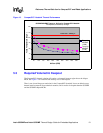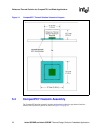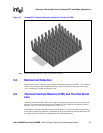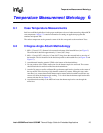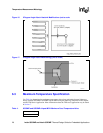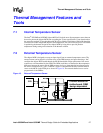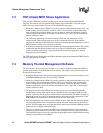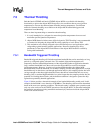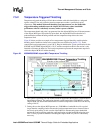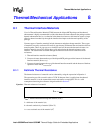
28 Intel
®
855GME and Intel
®
852GME Thermal Design Guide for Embedded Applications
Thermal Management Features and Tools
7.3 TDP chipset MCH Stress Application
Intel provides a TDP stress software tool that can be used to validate chipset MCH thermal
solutions. The software tool will generate high memory write bandwidths to stress the chipset
MCH. The usage model for this software will include the following steps:
1. During the validation phase, OEMs will run this program on their platforms under worse case
system loading and environmental conditions. Worse case conditions might include things
such as loading the maximum number of rows for memory, setting the operating system to
maximum performance mode, an ambient environment at 55º C, and a still air environment
with no external air drafts.
2. The TDP stress application will remain running and the junction temperature will be
monitored until it has reached steady state. At the completion of the test, if the junction
temperature of the chipset MCH does not exceed the maximum operating temperature (110º C)
then the thermal solution can be deemed as adequate.
3. If the junction temperature exceeds the maximum operating temperature then this will provide
an indication that the thermal solution needs to be improved. Modifications to the thermal
solution should be made and the system should be retested until the appropriate junction
temperature can be maintained.
The TDP application will also allow the OEM to determine appropriate bandwidth WRITE throttle
settings to program into the BIOS.
7.4 Memory Thermal Management Software
The Intel Memory Thermal Management Software is a software application that allows OEMs to
generate high memory read bandwidths to stress memory. The usage model for this software will
include the following steps:
1. Preparation before testing will include placing thermocouples on each of the memory devices
of the DDR DIMMs that are to be used during validation.
2. During the validation phase, OEMs will run this program on their platforms under worse case
system loading and environmental conditions. Worse case conditions might include things
such as loading the maximum number of rows for memory, setting the operating system to
maximum performance mode, an ambient environment of 55 ºC, and a still air environment
with no external air drafts.
3. The program will allow the OEM system designer to test at several different bandwidth
throttle settings. Some of the typical settings available for previous chipset MCHs were 65
percent, 55 percent, and 45 percent of the maximum write bandwidth. The OEM can begin by
running the test at one of the low bandwidth settings and monitoring the temperatures on the
DDR DIMMs. The temperatures should be allowed to reach steady state.
4. Once the temperatures are at steady state the OEM can observe the data and determine whether
any of the temperatures have exceeded the maximum allowable temperature for the memory
devices. If all the temperatures are within the allowed specification then the OEM can proceed
to the next test at a higher bandwidth setting.
5. This process will be repeated until the OEM tests at a bandwidth throttle setting that causes
temperature specifications to be exceeded for either the memory devices or the bottom surface.
This bandwidth limit will be used to determine the appropriate memory READ throttle setting
that can be programmed into the BIOS.




